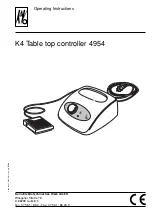
Instructions for Use
XLTEK Protektor32
6
Protektor32 – Intraoperative Neurophysiological
Monitoring
Indications for Use
The Protektor32 system, composed of both hardware and software, is intended to be used for
intraoperative neurological Monitoring. The instrument uses EEG, EP, EMG and Transcranial Stimulation
techniques (TcMEP) to provide the healthcare professionals with information to help assess a patient’s
neurological status during surgery.
The TcMEP mode is intended for intraoperative diagnosis of acute dysfunction in corticospinal axonal
conduction brought about by mechanical trauma (traction, shearing, laceration, or compression) or
vascular insufficiency.
The EPWorks software, an integral part of the system, is intended to allow a medical professional to
manually configure stimulation and acquisition parameters and to manually create EEG, EP, EMG and
TcMEP protocols according to their own requirements. The intended use for each of the software’s
outputs is as follows:
•
The EEG, EP, and EMG waveforms are intended to help the user assess a patient’s neurological
status during surgery.
•
Simple waveform parameters (e.g., amplitude, latency), and user-defined Fast Fourier Transform
(FFT) displays (CSA, DSA) are intended to help the user analyze the EEG and EP waveforms.
This device is intended to be used by qualified medical practitioners, trained in Electroencephalography,
Evoked Potentials and Electromyography, who will exercise professional judgment when using the
information.
Protocols
As stated by the America Academy of Neurology (2008) “[...] the quality, extent and type of monitoring [...]
is exquisitely reliant on the rigors of the monitoring procedure and protocols, and the clinical expertise of
the monitoring physician.” All things considered, Intraoperative neurophysiological monitoring depends on
the collection of data that will be judiciously interpreted by the trained professional to identify neurological
changes due to operative manipulations.
The Protektor32 offers flexibility to accommodate user needs for intraoperative monitoring. It provides an
easily accessible interface to quickly set up protocols when performing the following intraoperative
monitoring procedures:
•
Central Sulcus Mapping:
A method for intraoperative determination of the central sulcus using
SSEP and/or Motor Evoked Potentials.
•
Pedicle Screw Stimulation:
A method or technique for monitoring pedicle screw placement and
performed by applying stimulation of the “pedicle screw” and recording the evoked EMG activity from
the muscles innervated by the spinal nerve roots at risk.
•
Direct Nerve Stimulation:
A method used to evaluate damaged nerves. It is based on the possibility
to record and analyze a type of evoked potential (EP) called Nerve action potential (NAP) which is a
the total electrical potential that develops and travels within a nerve after its constituent nerve fibers
have been stimulated- either physiologically or physically- to a level above their threshold.
The above reflects TcMEP protocols only as they relate to the intended use of the Protektor32.
Содержание XLTEK Protektor32
Страница 1: ...XLTEK Protektor32 Instructions for Use...
Страница 2: ......
Страница 4: ......
Страница 29: ...XLTEK Protektor32 Instructions for Use 27...
Страница 60: ...Instructions for Use XLTEK Protektor32 58...









































